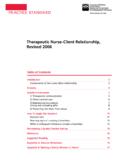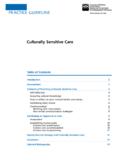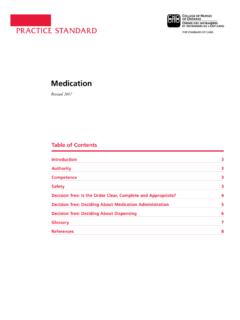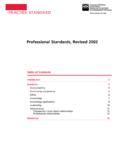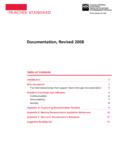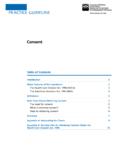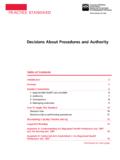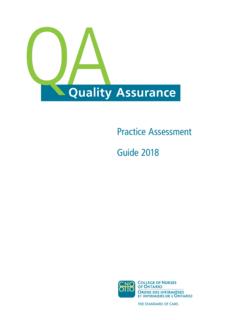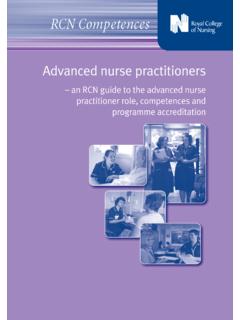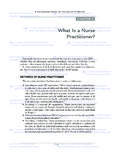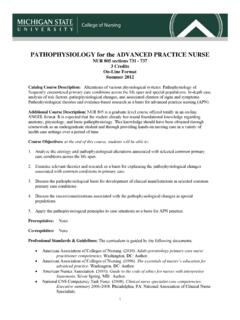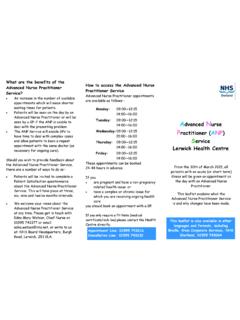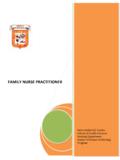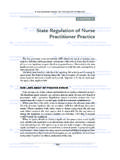Transcription of PRACTICE STANDARD Nurse Practitioner - CNO
1 PRACTICE STANDARDT able of Contents Introduction 3 Scope of PRACTICE 3 Nursing scope of PRACTICE statement 3 Controlled acts 3 Other authorized activities 4 standards 4 Health Assessment 4 Diagnosis 4 Therapeutic Management 4 Collaboration, Consultation, and Referral 5 Conflict of Interest 6 Discontinuing the NP-client relationship 6 Legal requirements and restrictions 7 Delegation 7 Medical Assistance in Dying 7 Medication practices 7 Table 1: Medication practices : Legal Requirements and Restrictions 8 Glossary 10 Decision Tree for NPs: Deciding to Perform a Controlled Act 12 References 13 Nurse PractitionerRevised 2018 Nurse Practitioner Pub.
2 No. 41038I S BN 978 -1-77116 -110 -7 Copyright College of Nurses of Ontario, or for-profit redistribution of this document in part or in whole is prohibited except with the written consent of CNO. This document may be reproduced in part or in whole for personal or educational use without permission, provided that: Due diligence is exercised in ensuring the accuracy of the materials reproduced; CNO is identified as the source; and The reproduction is not represented as an official version of the materials reproduced, nor as having been made in affiliation with, or with the endorsement of, Published May 1998 Revised March 2003 as standards of PRACTICE for Registered Nurses in the Extended Class (Revised 2003) (ISBN 1-894557-33-6), Reprinted as Extended Class in 2004, Revised March 2003 as standards of PRACTICE for Registered Nurses in the Extended Class (Revised 2003) ISBN 1-894557-37-9, reprinted December 2005.
3 Revised June 2008 as Nurse Practitioners. (ISBN 1-897308-50-7), Updated June 2009. Revised October 2011 as Nurse Practitioner . Updated January 2016 for Providing orders. Updated February 2017. Revised 2017 for revised Ontario Regulation 275/94 (General) under the Nursing Act, 1991. (ISBN 978-1-77116-076-6) Revised January & March 2018 following amendments to the Ontario Regulation 107/96 (General) under the Regulated Health Professions Act, 1991. (ISBN 978-1-77116-094-0). Updated May 2018 following amendments to the Narcotic Control Regulations ( , c. 1041) and the New Classes of Practitioners Regulations (SOR/2012-230) under the Controlled Drug and Substances Act. (ISBN 978 -1-77116 -106 - 0)Additional copies of this document may be obtained by contacting CNO s Customer Service Centre at 416 928-0900 or toll-free in Canada at 1 800 of Nurses of Ontario 101 Davenport Rd. Toronto, ON M5R fascicule existe en fran ais sous le titre : Infirmi res autoris es de la cat gorie sp cialis e, no 51038 VISION Leading in regulatory excellenceMISSION Regulating nursing in the public interestPRACTICE STANDARD3 College of Nurses of Ontario PRACTICE STANDARD : Nurse PractitionerIntroductionThe College of Nurses of Ontario s (the College s) standards inform nurses of their accountabilities and the public about what to expect of nurses.
4 These expectations contribute to public protection and are the benchmark for how a competent Nurse should perform. This Nurse Practitioner PRACTICE STANDARD describes the accountabilities specific to Nurse Practitioners (NPs) in Ontario (also known as Registered Nurses in the Extended Class). NPs are also accountable for complying with relevant laws and other College standards and guidelines1 as are Registered Nurses who have met additional nursing education, experience and exam requirements set by the College. Only those registered with the College in the Extended Class can call themselves Nurse Practitioner or NP . NPs are authorized to diagnose, order and interpret diagnostic tests, and prescribe medications and other treatments for clients. NP PRACTICE includes health promotion with the aim of optimizing the health of people, families, communities and populations. This enables NPs to PRACTICE with diverse client populations in a variety of contexts and PRACTICE settings such as acute care, primary care, rehabilitative care, curative and supportive care, and palliative/end-of-life care.
5 The College registers NPs with one or more of the following specialty certificates: Nurse Practitioner Primary Health Care (NP-PHC) Nurse Practitioner Pediatrics (NP-Pediatrics) Nurse Practitioner Adult (NP-Adult).Each specialty certificate refers to a specific client population and not a clinical area or a PRACTICE sector. The College does not restrict the clinical areas or sectors in which NPs of practiceThe Regulated Health Professions Act, 1991 (R HPA) and Nursing Act, 1991 set the legal framework for the PRACTICE of nursing. This includes a scope of PRACTICE statement and a number of controlled acts NPs are authorized to scope of PRACTICE statementThe following statement applies to all nurses:The PRACTICE of nursing is the promotion of health and the assessment of, the provision of care for and the treatment of health conditions by supportive, preventive, therapeutic, palliative and rehabilitative means in order to attain or maintain optimal function (Nursing Act, 1991).
6 Controlled actsUnder the Nursing Act, NPs are authorized to perform the following controlled acts:21. Communicating to a client, or a client s representative, a diagnosis made by the Performing a procedure below the dermis or a mucous Putting an instrument, hand or finger:i. beyond the external ear canal;ii. beyond the point where the nasal passages normally narrow;iii. beyond the larynx;iv. beyond the opening of the urethra;v. beyond the labia majora;vi. beyond the anal verge; orvii. into an artificial opening of the Applying and ordering the application of a prescribed form of Setting or casting a bone fracture or joint Administering a substance by injection or Prescribing, dispensing, selling or compounding a Treating, by means of psychotherapy technique, delivered through a therapeutic relationship, an individual s serious disorder of thought, 1 All standards and guidelines are available at: See pages 12-19 for legal requirements and restrictions that apply to some controlled STANDARD4 College of Nurses of Ontario PRACTICE STANDARD : Nurse Practitionercognition, mood, emotional regulation, perception or memory that may seriously impair the individual s judgement, insight, behaviour, communication or social authorized activitiesNPs have the authority to order and apply specified tests.
7 For the most up-to-date list, please visit our website at section describes standards for NP PRACTICE . NPs: practise according to College standards , guidelines, and relevant laws. use the protected title Nurse Practitioner (NP) or Registered Nurse Extended Class (RN(EC)), and may add their specialty certificate(s) to their title. maintain competence in clinical NP PRACTICE . This clinical PRACTICE must include the use of advanced nursing knowledge and decision-making skill in health assessment, diagnosis and therapeutics when treating clients appropriate for the NP s specialty certificate. demonstrate the NP competencies applicable to their PRACTICE . limit their PRACTICE to clients appropriate for their specialty certificate. Health Assessment NPs integrate an evidence-informed knowledge base with advanced assessment skills to obtain the information necessary for identifying client diagnoses, strengths and : conduct a comprehensive or focused health assessment as appropriate to the individual client s presentation.
8 Perform procedures for client assessments. obtain and consider the necessary information for the health assessment. identify urgent, emergent and life-threatening are engaged in the diagnostic process and develop differential diagnoses through identification, analysis, and interpretation of findings from a variety of : consider the differential diagnoses and establish the probable diagnoses. order appropriate tests. perform appropriate procedures. arrange appropriate follow-up of test results; implement reliable systems for test results to be received and communicated in a timely manner, and work with organizations in which they PRACTICE to implement such systems. communicate clinically significant results, and their implications, to the client and other health professionals as appropriate. communicate diagnoses to the client, including discussing relevant clinical information, treatment plans and the expected outcomes and prognoses.
9 Verify that the client understands information related to relevant findings and their ManagementNPs, on the basis of assessment and diagnosis, formulate the most appropriate plan of care for the client and implement evidence-informed therapeutic interventions in partnership with the client to optimize health. NPs: formulate and document a plan of care based on assessment findings, diagnosis and evidence-informed PRACTICE . select the appropriate treatments or interventions in collaboration with the client. perform appropriate procedures. stay informed about reliable quality assurance systems in their PRACTICE setting and advocate for reliable systems if there are none. intervene to stabilize the client in urgent, emergent and life-threatening situations. provide pharmacological interventions, treatment, or therapy by: reviewing the best possible medication history for the client Selecting pharmacotherapeutic options as PRACTICE STANDARD5 College of Nurses of Ontario PRACTICE STANDARD .
10 Nurse Practitionerindicated by diagnosis based on determinants of health, evidence-informed PRACTICE , and client preference counselling the client on pharmacotherapeutics, including rationale, cost, potential adverse effects, interactions, contraindications and precautions, as well as reasons to adhere to the prescribed regimen and required monitoring and follow-up completing accurate prescription(s) in accordance with applicable laws establishing a plan to monitor the client s response to medication therapy, and continue, adjust or discontinue a medication based on assessment of the client s response applying strategies to reduce risk of harm involving controlled substances, including medication misuse, addiction, and diversion develop and implement an appropriate follow-up and monitoring plan in collaboration with the Substances In addition to the standards for therapeutic management listed above, NPs have other accountabilities when prescribing and dispensing controlled substances.
